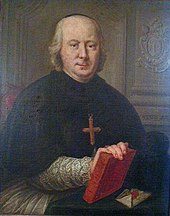Clairmarais Monastery
| Clairmarais Cistercian Abbey | |
|---|---|
 Remains of the cloister and dormitory |
|
| location |
Region Hauts-de-France Pas-de-Calais |
| Coordinates: | 50 ° 46 ′ 7 " N , 2 ° 18 ′ 19" E |
| Serial number according to Janauschek |
145 |
| founding year | 1140 |
| Year of dissolution / annulment |
1791? |
| Mother monastery | Clairvaux Monastery |
| Primary Abbey | Clairvaux Monastery |
|
Daughter monasteries |
no |
The Clairmarais Monastery (Clarus Mariscus) is a former Cistercian abbey in the commune of Clairmarais in the Pas-de-Calais department , Hauts-de-France , in France , around 4 km northeast of Saint-Omer in the marshland of the Marais east of the Aa river .
history
The monastery was in 1140 by the Count of Flanders Thierry, Count of Flanders and his wife Sibylle of Anjou donated and the Branch Clairvaux settled whose filiation it belonged. The facility was built according to the plans of Geoffroy d'Ainay. The church was built in the Gothic style and its construction lasted over three centuries. The monastery owned several grangs , including the Klostergrangie and the Grangien Neuville, Furnes, Beaumont, Enne, Leulinghem, Maninghem-au-Mont, Muncq-Nieurlet, Rihoult, Loo et Beauloo, Ostreville, Antin, Monchy-Cayeux, FiefsQuevraussart, Livossart, Laires, Bomy, Beaumetz-lès-Aire, Fevin, Prés de Dixmude. During the French Revolution , the monastery came to an end and was almost completely destroyed as a result.
Buildings and plant
The agricultural buildings have been preserved, including a barn over 100 meters long and the pigeon house from 1731. The entrance area and the foreign chapel (partly inscribed as a monument historique ) are partly preserved . Only small remains of the buildings of the enclosure have survived, namely a part of the cloister with the wall of the dormitory above . The church was completely removed in 1802.
literature
- Henri de Laplane: L'abbaye de Clairmarais d'après ses archives. Volume 2. Fleury-Lemaire, Saint-Omer 1868.
- Bernard Peugniez: Routier cistercien. Abbayes et sites. France, Belgique, Luxembourg, Suisse. Nouvelle édition augmentée. Éditions Gaud, Moisenay 2001, ISBN 2-84080-044-6 , pp. 302-303.

